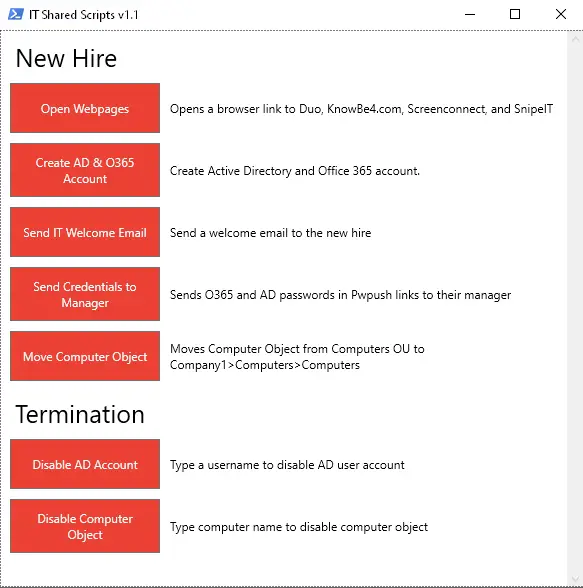

- #Powershell display menu to user how to#
- #Powershell display menu to user full#
- #Powershell display menu to user code#
- #Powershell display menu to user windows#
$DropDownLabel.Location = new-object (10, 10) $DropDown.Location = new-object (100, 10) # This Function Returns the Selected Value and Closes the Form $DropDownArray = $DropDownArrayItems | sort The MessageBox class has one primary method called Show. Add-Type -AssemblyNamePresentationFramework Once this is done, we can now use the MessageBox class. You'll do this by adding the PresentationFramework assembly by using the Add-Type cmdlet. You can also do something like this: $DropDownArrayItems = "Start VPN", "Stop VPN", "Cancel" To use it, you'll need to add the assembly into your PowerShell session. How would I go about just clipping out the segment I want, and assigning it to the variable in question? You can list folder NTFS permissions with PowerShell: Get-ACL.
#Powershell display menu to user windows#
Now I want the output of the script to just give the state name, and be held as a variable, let's just say $State You can use Windows Start Menu search to quickly find an app, file, setting item. $selection = Read-Host "Please make a selection" Step 1: In windows 10, click on the Start button to open the Start menu. And that is where you lost me… And this might just be a super simple question, but like I said, I have been working with PowerShell for all of 3 days now… Run PowerShell as an Administrator from Start Menu. I've created the script just prior to the do / until section. And please forgive my newness to PowerShell, I am a Linux guy diving head first into PowerShell. Hopefully you are still monitoring this feedback and responding, I know this article is old. $input = Read-Host "Please make a selection" Write-Host "3: Press '3' for HP Mailboxes." Write-Host "2: Press '2' for MC Mailboxes." Write-Host "1: Press '1' for HC Mailboxes."

I seemed to have narrowed this down to the "sort" option in my menu item. What I want it to do is give me results and pause at the end of those results so I can review them. The first time I run it, I get the menu, make a "1" selection (get-mailbox), it pauses, but I get no results. I have a problem with my script, which matches closely to what is above. When ran with the title parameter set to 'My Menu', it will look like this: Show-Menu –Title 'My Menu' This is a simple function that first clears the console and then writes a few lines to it. Write-Host "3: Press '3' for this option." Write-Host "2: Press '2' for this option." Write-Host "1: Press '1' for this option."
#Powershell display menu to user code#
This menu consists of two main components: a function that displays the menu, and a switch statement that takes the input and directs the code which way to go, depending on the selection.
#Powershell display menu to user how to#
Let’s go over how to build a rudimentary interactive menu in the PowerShell console. I also keep a version number in the variable $ncVer.Constructing an interactive menu that allows the user to select between different options is a great way to build scripts for less PowerShell-savvy people, or it can simply be used as a kind of input gateway to a lot of the functionality that you’ve already built in PowerShell. This is of course, very important, as who doesn't want to sometimes tweak the color output of your scripts? I like to keep that set as a global variable so it can be changed later if desired.

#Powershell display menu to user full#
You'll want to define the variable $foregroundColor to see the full effect of the following code. Write-Host is my favorite way to do this. The first thing you'll need to do is present the user with options. Once there were more than 6 different functions I created a basic menu system for the Helpdesk to use when using PowerShell with my module. Some functions were for creating new hires, others for terminations, and even more for general AD user account and Exchange management. In this module there were a ton of functions. I wrote a script that became a module that the whole team would use. As I dove deeper into PowerShell years ago I started to think about ways to help those utilizing my scripts.


 0 kommentar(er)
0 kommentar(er)
